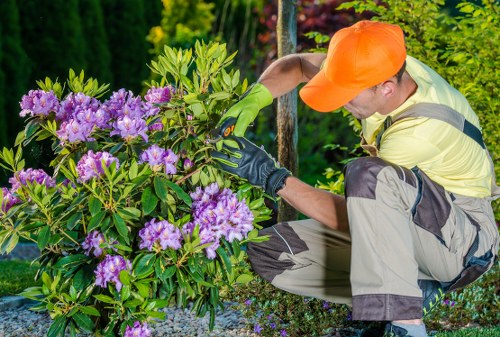Mastering Hedge Trimming in Highgate: Tips and Techniques
Understanding the Importance of Hedge Trimming

Hedge trimming is a crucial aspect of garden maintenance, especially in areas like Highgate where the climate and soil conditions can influence plant growth. Regular trimming not only enhances the aesthetic appeal of your garden but also promotes healthy growth and prevents diseases.
Benefits of Regular Hedge Trimming:
- Promotes healthy growth
- Enhances garden aesthetics
- Prevents pest infestations
- Maintains desired shape and size
Why Choose Hedge Trimming Services in Highgate

Highgate residents have access to a range of professional hedge trimming services that cater to various types of hedges, from formal box hedges to natural, informal varieties. Professional trimming ensures that your hedges are cut with precision, maintaining their health and beauty.
Advantages of Professional Services:
- Expert knowledge of local plant species
- Access to specialized tools
- Time-saving for homeowners
- Consistent and high-quality results
Choosing the Right Tools for Hedge Trimming

Having the right tools is essential for effective hedge trimming. Whether you're a DIY enthusiast or planning to hire professionals, understanding the tools involved can help achieve the best results.
Essential Hedge Trimming Tools:
- Pruning Shears
- Hedge Trimmers
- Loppers
- Strimmers
- Protective Gear
Best Practices for Hedge Trimming

Implementing best practices ensures that your hedges remain healthy and vibrant. Proper trimming techniques can prevent damage and promote robust growth.
Top Trimming Tips:
- Trim during the right season
- Maintain consistent shapes
- Avoid cutting too much at once
- Regularly clean and sharpen your tools
Seasonal Hedge Trimming in Highgate

Different seasons call for different trimming techniques. Understanding when and how to trim your hedges can make a significant difference in their growth and appearance.
Seasonal Guidelines:
- **Spring:** Light trimming to encourage new growth
- **Summer:** Shaping and maintaining size
- **Autumn:** Preparing for winter by cutting back stubborn branches
- **Winter:** Minimal trimming, focusing on removing dead wood
Common Mistakes to Avoid
Even with the best intentions, certain mistakes can hinder the health and appearance of your hedges. Being aware of these can help you maintain vibrant and healthy plants.
Frequent Errors:
- Over-trimming, which can stress the plant
- Using dull tools that tear the foliage
- Ignoring the specific needs of different hedge types
- Not following up with proper care after trimming
Hiring a Professional Hedge Trimming Service
While DIY trimming is possible, hiring a professional service in Highgate can ensure optimal results. Professionals bring experience, knowledge, and the right equipment to handle any hedge trimming job efficiently.
What to Look for in a Service:
- Experience and expertise
- Positive customer reviews
- Range of services offered
- Competitive pricing
- Insurance and guarantees
Cost of Hedge Trimming in Highgate
The cost of hedge trimming can vary based on several factors, including the size of the hedges, their type, and the complexity of the job. Understanding the pricing structure can help you budget effectively.
Pricing Factors:
- Size and height of the hedges
- Type of plants
- Accessibility of the area
- Frequency of trimming required
- Additional services like disposal of clippings
Environmental Considerations
Trimming hedges responsibly ensures minimal impact on the environment. Sustainable practices benefit not only your garden but also the broader ecosystem.
Eco-Friendly Practices:
- Using electric or battery-powered tools to reduce emissions
- Composting clippings instead of sending them to landfill
- Selecting native plant species that require less maintenance
- Avoiding the use of harmful chemicals during maintenance
Maintaining Your Hedges Between Trims
Proper maintenance goes beyond trimming. Regular care ensures that your hedges remain healthy and attractive all year round.
Maintenance Tips:
- Regular watering, especially during dry periods
- Fertilizing to provide essential nutrients
- Monitoring for pests and diseases
- Pruning dead or damaged branches promptly
Tools and Equipment Maintenance
Keeping your hedge trimming tools in good condition is vital for effective gardening. Well-maintained tools ensure clean cuts and prolong the life of your equipment.
Maintenance Guidelines:
- Clean tools after each use
- Sharpen blades regularly
- Store tools in a dry place to prevent rust
- Inspect equipment for damage before each use
- Replace worn-out parts promptly
Safety Tips for Hedge Trimming
Hedge trimming involves the use of sharp tools and sometimes climbing ladders, making safety a top priority. Adhering to safety practices prevents accidents and injuries.
Essential Safety Measures:
- Wear appropriate protective gear, including gloves and goggles
- Ensure tools are in good working condition
- Be cautious when working at heights
- Keep the work area free of obstacles and hazards
- Follow manufacturer instructions for all equipment
Choosing the Right Hedge Variety for Highgate Gardens
Selecting suitable hedge varieties is crucial for achieving the desired look and maintaining ease of care. Highgate's climate supports a diverse range of hedges, each with unique characteristics.
Popular Hedge Varieties:
- Boxwood
- Privet
- Laurel
- Yew
- Photinia
Boxwood Hedges: Classic and Elegant
Boxwood is a favorite for formal gardens due to its dense foliage and ability to hold precise shapes. Regular trimming ensures a neat and sophisticated appearance.
Care Tips for Boxwood:
- Trim twice a year, ideally in spring and late summer
- Avoid cutting into bare stems
- Provide well-draining soil and consistent watering
Environmental Benefits of Well-Trimmed Hedges
Beyond aesthetics, well-trimmed hedges offer substantial environmental benefits. They act as natural barriers, support wildlife, and contribute to the overall health of your garden ecosystem.
Key Environmental Benefits:
- Provide habitat for birds and beneficial insects
- Act as windbreaks, reducing soil erosion
- Filter pollutants from the air
- Maintain soil moisture levels
- Enhance biodiversity in your garden
Seasonal Challenges in Hedge Maintenance
Each season brings its own set of challenges for hedge maintenance. Being prepared helps in addressing issues effectively and maintaining hedge health throughout the year.
Season-Specific Challenges:
- Spring: Dealing with new growth and potential pests
- Summer: Managing heat stress and ensuring adequate hydration
- Autumn: Preparing for dormancy and preventing disease
- Winter: Protecting hedges from frost and heavy snow
Innovative Hedge Trimming Techniques
Modern hedge trimming incorporates innovative techniques to enhance efficiency and results. Techniques like topiary and sculptural trimming add unique artistic elements to your garden.
Advanced Trimming Techniques:
- Topiary: Creating ornamental shapes
- Sculptural Trimming: Designing intricate patterns
- Selective Pruning: Focusing on specific branches for natural forms
- Layered Trimming: Creating depth and dimension
- Eco-Friendly Trimming: Minimizing environmental impact
Integrating Technology in Hedge Trimming
Technology has revolutionized garden maintenance, including hedge trimming. Tools like electric trimmers and automated systems make the process more efficient and precise.
Technological Advancements:
- Battery-powered trimmers for cordless convenience
- Smart sensors to monitor hedge health
- Automated trimming systems for large gardens
- Advanced safety features in modern tools
- Eco-friendly innovations reducing carbon footprint
DIY Hedge Trimming vs. Professional Services
Deciding between DIY hedge trimming and hiring professionals depends on various factors, including your skill level, the size of your garden, and the complexity of the trimming required.
Pros and Cons:
- DIY: Cost-effective, personal satisfaction, flexible timing
- Professional: Expert results, time-saving, access to specialized tools
When to Hire a Professional Trimmer
Consider hiring a professional trimmer for large or complex jobs, when dealing with hard-to-reach areas, or if you lack the necessary tools and expertise. Professionals can ensure the job is done efficiently and to a high standard.
Ideal Scenarios for Hiring:
- Extensive hedge systems
- Specialized trimming requirements
- Time constraints
- Desire for professional aesthetics
Preparing Your Garden for Hedge Trimming
Proper preparation is key to successful hedge trimming. Ensuring your garden is ready can make the process smoother and more effective.
Preparation Steps:
- Clear the area around the hedge
- Gather all necessary tools
- Check tools for safety and functionality
- Plan the trimming pattern and design
- Ensure proper lighting if trimming in the evening
Aftercare Following Hedge Trimming
After trimming, proper aftercare ensures your hedges recover well and continue to thrive. This includes cleaning up, applying nutrients, and monitoring for any issues.
Aftercare Tips:
- Dispose of or compost trimmed branches
- Water the hedges to reduce stress
- Apply fertilizer if needed
- Inspect for pests or diseases
- Schedule the next trimming session
Conclusion: Achieving Perfect Hedges in Highgate
Mastering hedge trimming in Highgate involves understanding your plants, using the right tools, and applying best practices. Whether you choose to DIY or hire professionals, maintaining your hedges ensures a beautiful and healthy garden year-round.
Ready to transform your garden? Contact us today to book your hedge trimming service and enjoy a pristine garden.
Frequently Asked Questions
Get In Touch With Us.
Please fill out the form below to send us an email and we will get back to you as soon as possible.

